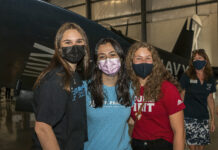Whether you call it technology transfer, cross-pollination or inter-industry brainstorming, more and more air show professionals are recognizing the value of looking beyond traditional sources of new ideas for their air show business. Big shows and small shows. NASCAR races and cub scout carnivals. Civil war re-enactments and rock and roll concerts. The ideas and inspiration are out there; you just need to have enough imagination to recognize them.
For more than 30 years, the annual ICAS convention has provided event organizers, performers and support service providers with invaluable opportunities to share ideas, learn from one another and avoid re-inventing wheels that have already been spinning successfully for years. Every December, newcomers come to the convention to learn some of those lessons all over again and even the most grizzled veteran will pick up new information and insight from their colleagues.
In addition, our ICAS Academy, Air Shows Magazine and the informal conversations our members have with one another have allowed the air show industry to share ideas, information, and processes in ongoing and unprecedented fashion.
What has made that process successful has been the multi-directional flow of information. Event organizers learn from concessionaires. Concessionaires benefit from the insights of performers. Civilian event organizers pass along tidbits to military event organizers. Big shows learn from small shows. Small shows learn from big shows.
Progressive air show professionals understand that no particular segment of the air show community has a monopoly on good ideas and that it is to our industry’s collective benefit that we make use of all the resources available to us. A small show in the Southeastern United States can learn a lot from the organizers of EAA’s AirVenture even if Oshkosh is 100 times bigger. But there’s also a lot that a large, established show can learn from an innovative and well-run small show. And, by virtue of the many shows they participate in each year, performers and concessionaires can be an invaluable source of interesting ideas even if they have never actually put on an air show themselves.
But it’s vital that, as an industry, we don’t become so comfortable with our intra-industry communications network that we ignore all the other sources of vision, inspiration and insight available to us. Whether it’s Cirque du Soleil, traveling Renaissance festival troupes or a local arts and crafts festival, the non-air show world is ripe with ideas that can be successfully and productively applied to our business.
It’s nice to hear a presentation on corporate sponsorship from an air show held in a very similar type of city with exactly the same size audience and exactly the same budget. But, when the opportunity presents itself, it’s probably more important and more enlightening to pay attention to the corporate sponsorship plans for a local symphony, a new children’s museum or a regional series of 10 kilometer running races. It takes a bit more work to translate and adapt ideas from outside our industry to our own needs and circumstances, but – as our industry continues to mature – it will almost certainly be individuals and situations outside of our immediate air show family that generate the next big ideas.
But you won’t hear them if you’re not listening for them.








